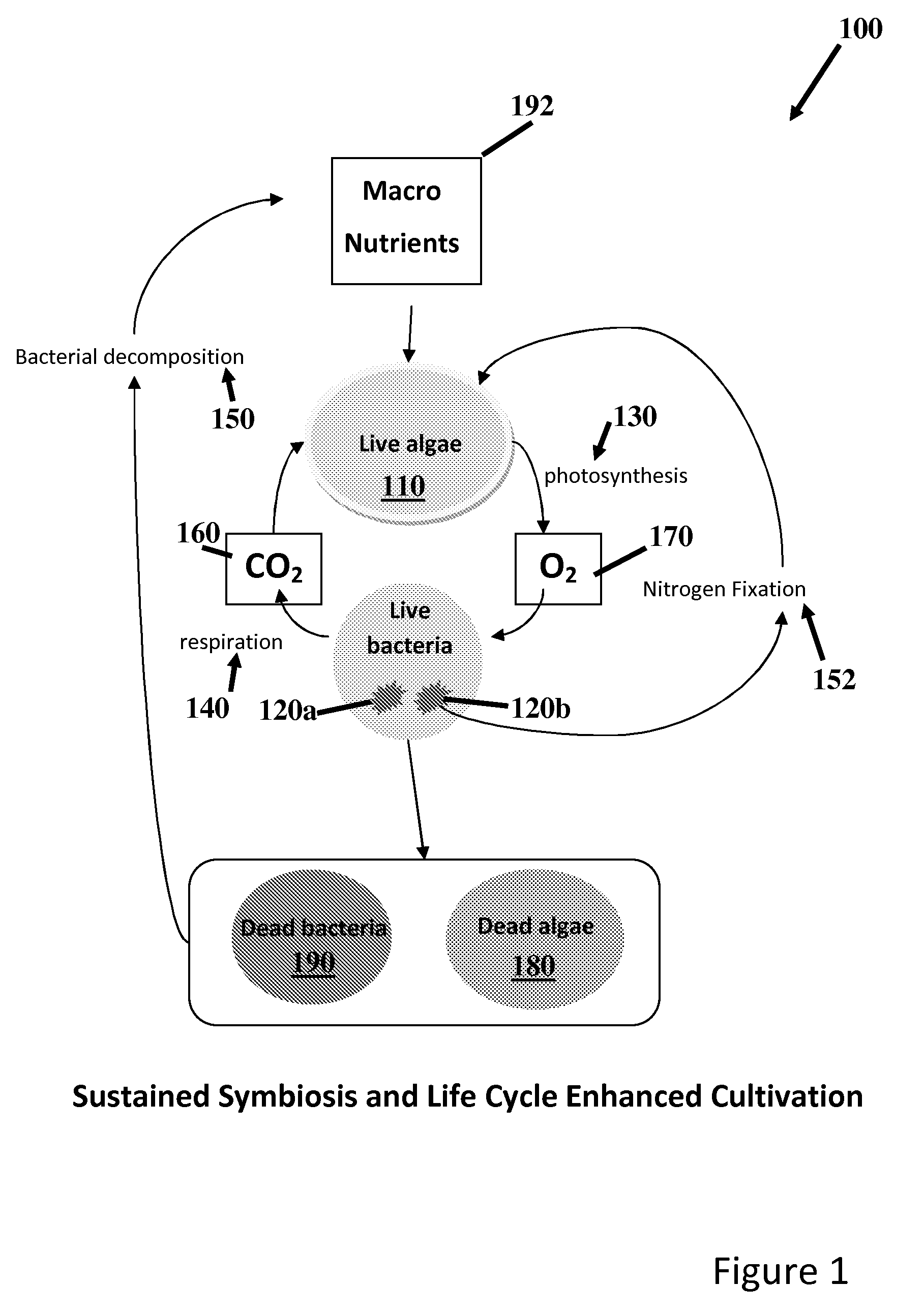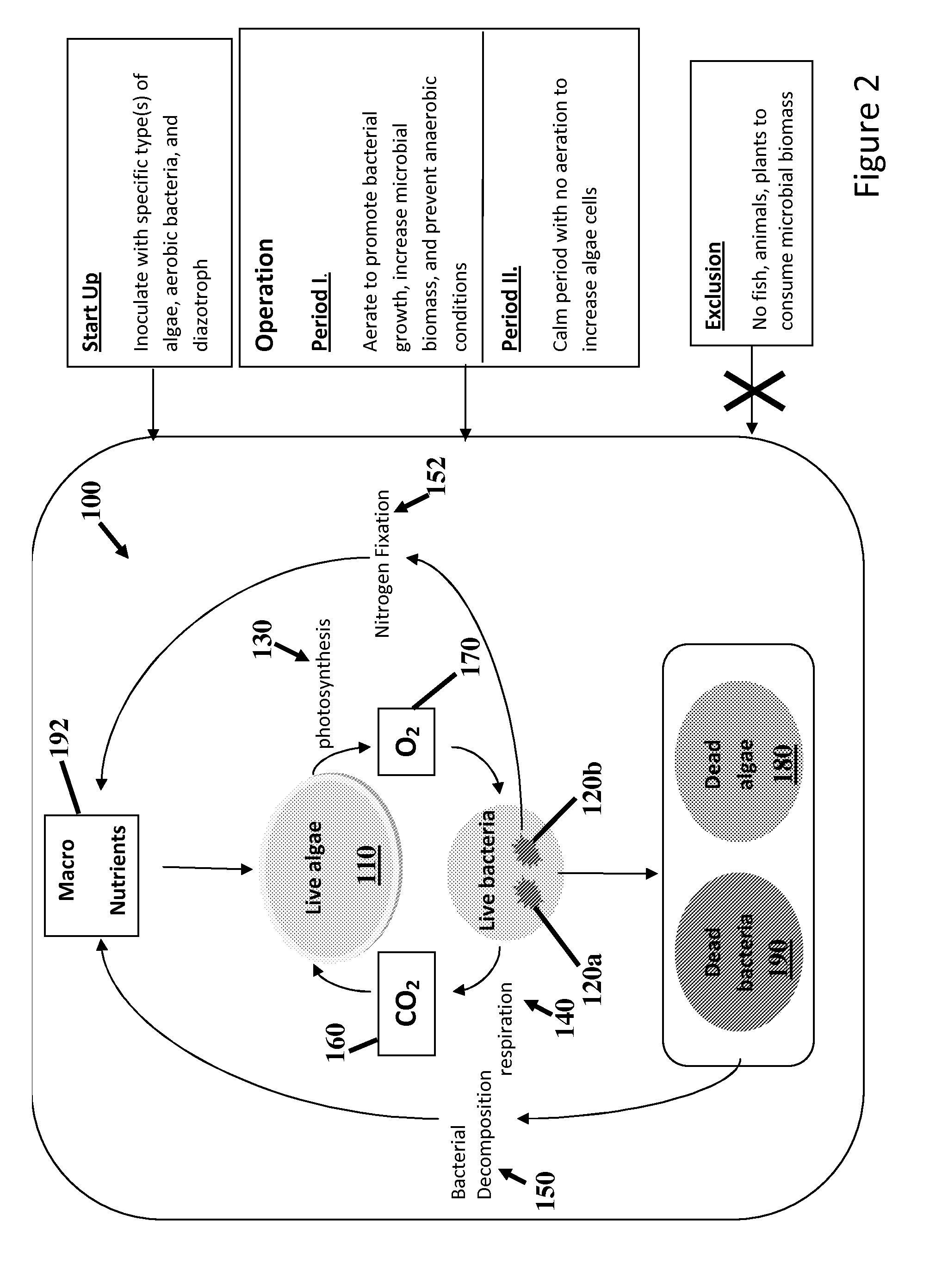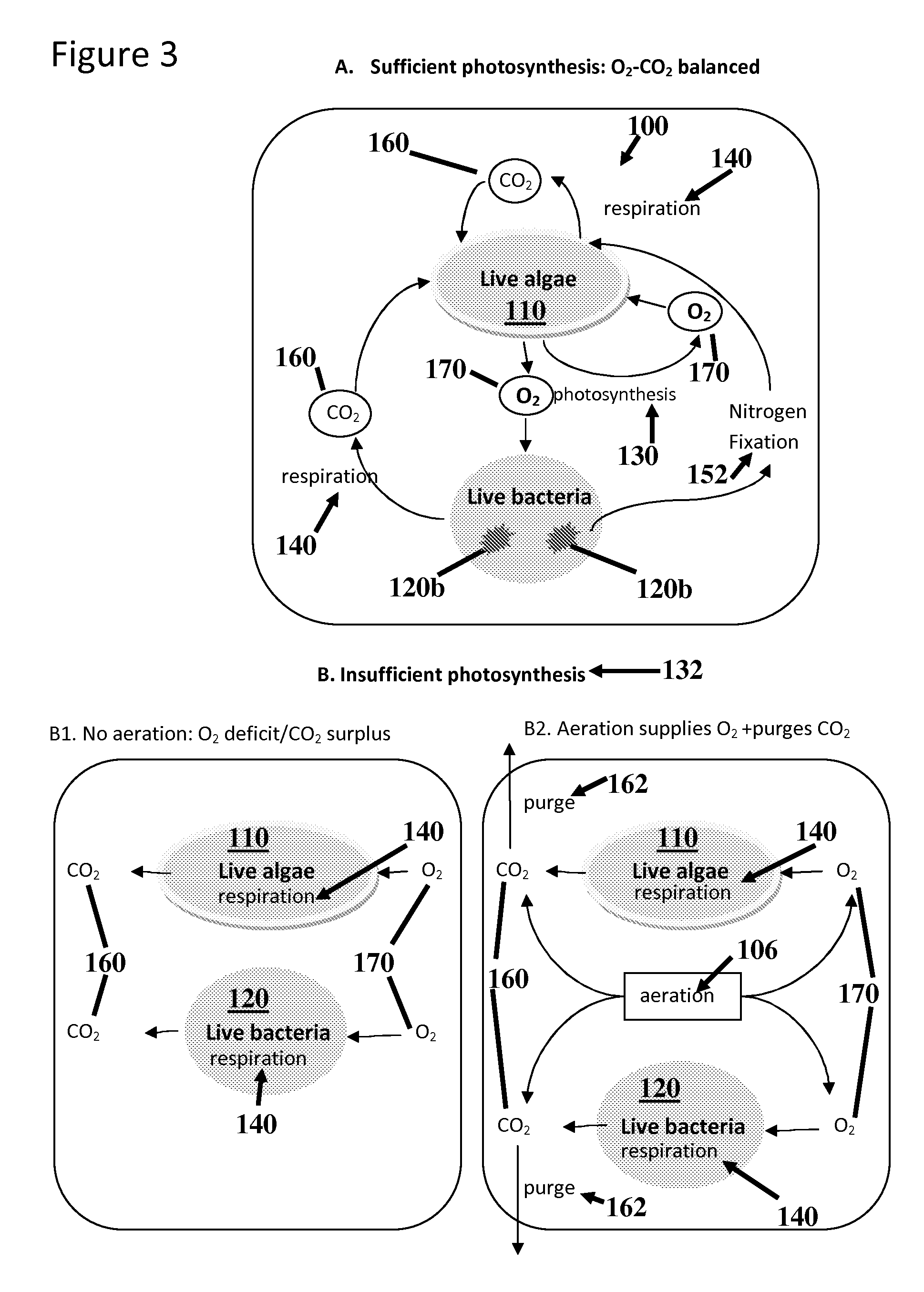[0009]In particular preferred aspects, maintaining a balanced symbiotic co-culture as described herein not only enables
algal growth using low exogenous
nutrient growth addition, but enables algal growth with a diazotroph-attenuated, stress-enhanced bioproduct (e.g., lipid, oil, TAG) yield (e.g., on a per-algal
cell basis) using low exogenous
nutrient growth addition. Applicant refers to this herein as symbiotic diazotroph-attenuated nitrogen stress co-cultivation (DANSC). While nitrogen stress responses in algae are known in the art, prior art attempts at using nitrogen stressed to induce algal bioproduct production have been limited to closed-
system bioreactors where algae are initially non-symbiotically grown in rich chemical medium to provide a large algal biomass, followed by imposing nitrogen deprivation by rapid exhaustion and / or adjustment of nutrients in the medium of the
closed system to induce nitrogen stress responses, followed by complete batch harvesting of the nitrogen stress algal biomass; that is, prior art methods comprise non-continuous batch processes that are suitable for closed systems only. By contrast, Applicant's inventive methods comprise the use of continuous symbiotic diazotroph-attenuated nitrogen stress co-cultivation (DANSC), as disclosed and taught herein, to provide for a continuous co-culture using diazotroph-attenuated nitrogen stress such that the advantages of nitrogen stress for algal bioproduct production can be implemented and sustained continuously in batch or non-batch processes, and in open and / or closed cultivation systems. Applicant's disclosed advantageous use of diazotrophs in the context of nitrogen-stressed algae is not only novel, but is counterintuitive and unexpected, because provision of bioavailable nitrogen to the algal co-cultures by addition of diazotrophs would not only be expected to decrease any advantages of nitrogen stress for algal bioproduct production, but would also be expected to cause nutrient depletion by the diazotrophs thereby limiting algal growth in the co-cultures. However, the Applicant has surprisingly discovered that symbiotic growth in the inventive co-cultures with diazotrophs provides for adequate sustained algal growth, while yet adequately preserving the advantages of nitrogen stress for algal bioproduct production by providing a balanced attenuated nitrogen stress response in the continuous co-culture. Applicant's methods, therefore, provide commercially adequate
biomass yield with a nitrogen-stress-enhanced bioproduct content, which, unlike prior art nitrogen stress batch processes, can be sustained on a continuous symbiotic basis in open or closed systems.
[0010]Particular aspects provide methods for enhanced
sustainable production of algal
bioproducts, comprising: providing a cultivation vessel containing an aqueous cultivation medium therein, the cultivation vessel in operative communication with suitable detection means to measure at least one of CO2, O2, nitrogen, and pH levels in the cultivation medium, and having an inlet in operative communication with a source of cultivation medium, and an outlet operative with the inlet and the cultivation vessel to provide for exchange of cultivation medium within the vessel; inoculating the cultivation medium in the vessel with at least one algal species, at least one aerobic bacterial species and at least one diazotroph; continuously cultivating the inocula under sustainable symbiotic co-culture conditions to provide for diazotroph-assisted sustained production of a harvestable amount of algal biomass; and repetitive harvesting of a portion of the algal biomass from the continuous co-culture, to provide for enhanced
sustainable production of at least one algal bioproduct.
[0011]Additional aspects provide methods for enhanced
sustainable production of algal
bioproducts, comprising: providing a cultivation vessel containing an aqueous cultivation medium therein, the cultivation vessel in operative communication with suitable detection means to measure at least one of CO2, O2, nitrogen, and pH levels in the cultivation medium, and having an inlet in operative communication with a source of cultivation medium, and an outlet operative with the inlet and the cultivation vessel to provide for exchange of cultivation medium within the vessel, the cultivation medium suitable to induce at least one nitrogen stress response in
algal cells cultured therein; inoculating the cultivation medium in the vessel with at least one algal species, at least one aerobic bacterial species and at least one diazotroph; continuously cultivating the inocula under sustainable symbiotic co-culture conditions, wherein the diazotroph component is maintained in an amount sufficient to sustainably attenuate the at least one nitrogen stress response in the symbiotically co-cultivated
algal cells to provide for diazotroph-assisted sustained production of a harvestable amount of algal biomass; and repetitive harvesting of a portion of the algal biomass from the continuous co-culture, to provide for enhanced sustainable production of at least one algal bioproduct.
[0012]Further aspects provide methods for enhanced sustainable production of algal
bioproducts, comprising: providing a cultivation vessel containing an aqueous cultivation medium therein, the cultivation vessel in operative communication with suitable detection means to measure at least one of CO2, O2, nitrogen, and pH levels in the cultivation medium, and having an inlet in operative communication with a source of cultivation medium, and an outlet operative with the inlet and the cultivation vessel to provide for exchange of cultivation medium within the vessel, the cultivation medium suitable to induce at least one nitrogen stress response in
algal cells cultured therein; inoculating the cultivation medium in the vessel with at least one algal species, at least one aerobic bacterial species and at least one diazotroph; continuously cultivating the inocula under sustainable symbiotic co-culture conditions, wherein at least a portion of the algal growth in the co-culture is photosynthetic, and wherein the diazotroph component is maintained in an amount sufficient to sustainably attenuate the at least one nitrogen stress response in the symbiotically co-cultivated algal cells to provide for diazotroph-assisted sustained production of a harvestable amount of algal biomass; and repetitive harvesting of a portion of the algal biomass from the continuous co-culture, to provide for enhanced sustainable production of at least one algal bioproduct.
[0013]Yet further aspects provide a method for enhanced sustainable production of algal bioproducts, comprising: providing a cultivation vessel containing an aqueous cultivation medium therein, the cultivation vessel in operative communication with suitable detection means to measure at least one of CO2, O2, nitrogen, and pH levels in the cultivation medium, and having an inlet in operative communication with a source of cultivation medium, and an outlet operative with the inlet and the cultivation vessel to provide for exchange of cultivation medium within the vessel; inoculating the cultivation medium in the vessel with at least one algal species, and at least one diazotroph; continuously cultivating the inocula under sustainable symbiotic co-culture conditions to provide for diazotroph-assisted sustained production of a harvestable amount of algal biomass; and repetitive harvesting of a portion of the algal biomass from the continuous co-culture, to provide for enhanced sustainable production of at least one algal bioproduct.
[0022]In particular embodiments of the methods, the co-culture provides, on a per-algal
cell basis, relative to non-symbiotic growth of the respective algal cells, for at least one of: enhanced total lipid production; enhanced production of triacylglycerols (TAGs); enhanced percentage of total lipid as TAGs; and enhanced percentage of saturated and mono-saturated fatty acids, relative to polyunsaturated fatty acids (PUFAs), in TAGs. In certain aspects of the methods, the total
lipid content is enhanced to a level equal to or greater than: 30%; 35%; 40%; 45%; or 50%
dry cell weight (DCW), or enhanced to a value in the range of from about 30% to about 50% DCW. In certain embodiments of the methods, the amount of total lipid in the form of triacylglycerols (TAGs) is equal to or greater than: 20%; 30%; 40%; 50%; 60%; 70%; or 80%
dry cell weight (DCW)of the total lipid, or in the range of from about 30% to about 80% DCW of the total lipid. In particular aspects of the methods, the increased percentage, relative to polyunsaturated fatty acids (PUFAs), of the saturated and mono-saturated fatty acids in the triacylglycerols (TAGs), is at least: 5%; 10%; 20%; 30%
dry cell weight (DCW); or greater, or is in the range of from about 10% to about 30% DCW.
 Login to View More
Login to View More  Login to View More
Login to View More 


